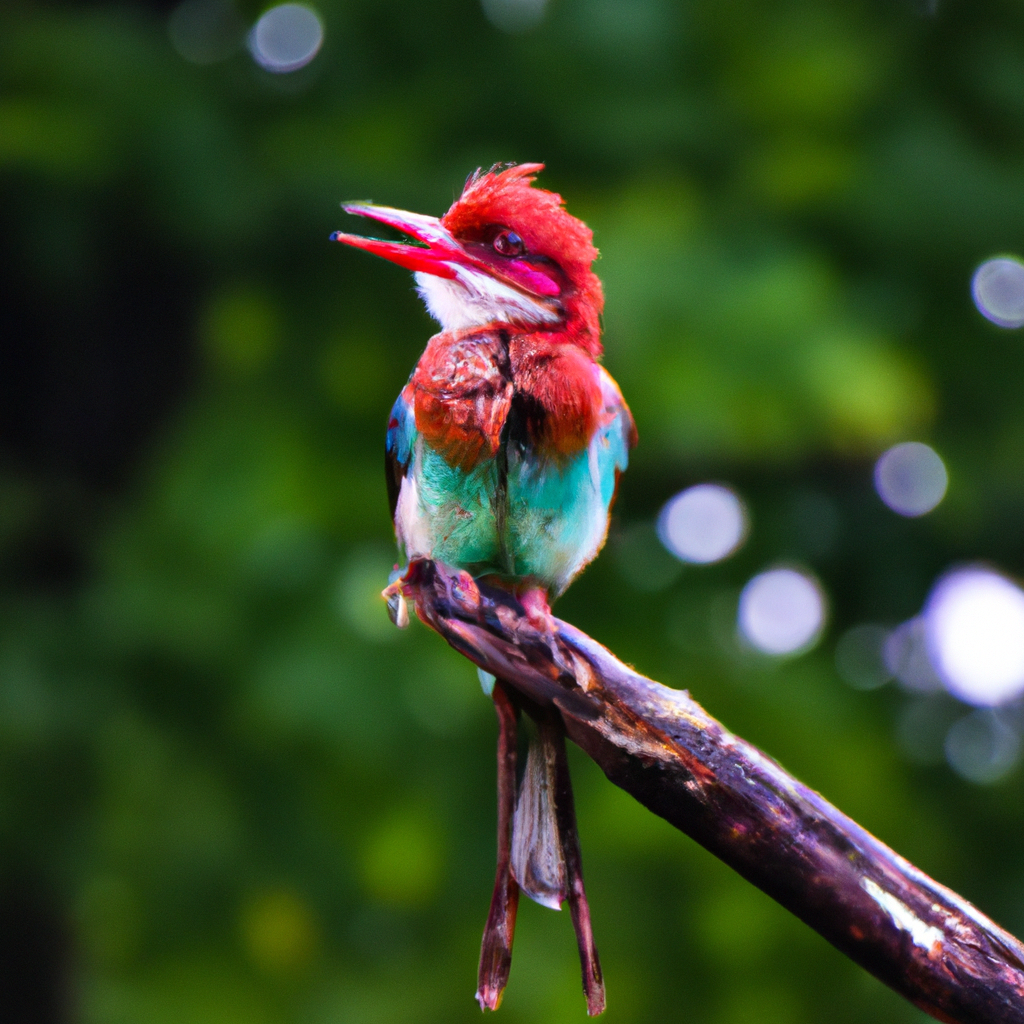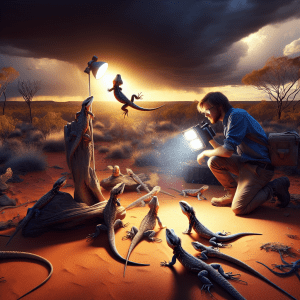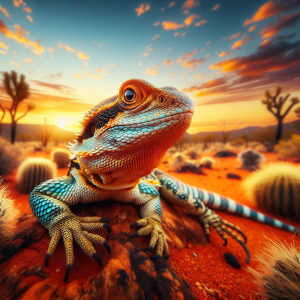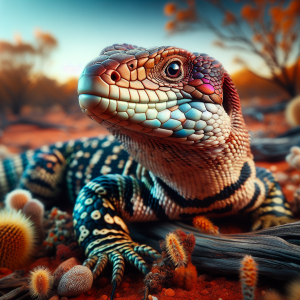Introduction: Lizards in the Australian Outback
Did you know that some lizards in the Australian Outback have a super cool trick up their sleeve? Picture this: you’re wandering through the vast Outback landscape, and suddenly you spot a lizard darting across the red earth. What you may not realize is that some of these lizards are actually masters of camouflage. They can change their skin color to blend seamlessly with their surroundings, making them nearly invisible to predators and unsuspecting prey. It’s like nature’s very own hidden talent show!
Imagine encountering a Thorny Devil, a unique lizard species found in the Outback, known for its spiky appearance and impressive water collection skills. These little critters can drink water through their skin by using capillary action to draw moisture from rain or dew. Talk about resourceful, right? It’s like having your own personal water bottle built into your body!
And here’s a fun fact to ponder over your latte: did you know that some Outback lizards can lose their tails as a defense mechanism? When faced with danger, these lizards can detach their tails, leaving them wriggling on the ground to distract predators while the lizard makes a swift escape. It’s like a lizard magic trick – now you see it, now you don’t!
These interesting tidbits about Australian Outback lizards truly showcase the incredible diversity and survival strategies of these fascinating creatures. It’s like stepping into a real-life nature documentary right in our own backyard. So, next time you find yourself in the Outback, keep an eye out for these amazing lizards and marvel at the wonders of the natural world around us.
What do you think about these quirky lizard facts? Have you ever encountered any unique wildlife surprises during your own adventures?
Types of Lizards Found in the Region
So, let’s talk about the best places to spot lizards in the Australian Outback. Picture this – you’re out in the vast, sun-drenched landscape, eager to catch a glimpse of these fascinating creatures in their natural habitat. Here’s a handy tip to enhance your lizard-spotting adventure: timing is key.
The Australian Outback is known for its extreme temperatures, with scorching heat during the day and cooler nights. If you want to increase your chances of spotting lizards, it’s advisable to plan your outings during the early morning or late afternoon when these cold-blooded reptiles are more active.
One of the prime locations to search for lizards is around rocky outcrops or crevices where they can bask in the sun to regulate their body temperature. Keep a keen eye out for movement or subtle rustling in the bushes – that might just be a lizard scurrying by!
Another tip that seasoned lizard enthusiasts swear by is to be patient and observant. Lizards are masters of camouflage, blending seamlessly into their surroundings to evade predators. Take your time to scan your surroundings carefully, focusing on areas with ample vegetation or rocky terrain where lizards are likely to seek shelter or hunt for food.
To truly immerse yourself in the experience, consider carrying a pair of binoculars to spot lizards from a distance without disturbing their natural behavior. Remember to move slowly and quietly to avoid startling these elusive creatures, allowing you to witness their unique behaviors up close.
By following these tips and techniques, you’ll be well-equipped to embark on a memorable lizard-spotting expedition in the awe-inspiring Australian Outback. So, grab your gear, embrace the spirit of adventure, and get ready to uncover the enchanting world of lizards in this rugged and captivating landscape. Happy lizard hunting!
Characteristics of Australian Outback Lizards
Let’s dive into section number VII, where we explore some interesting facts about Australian Outback lizards. Did you know that the thorny devil lizard, native to the Outback, has a unique way of collecting water? These little guys don’t need to drink from a water source; instead, they absorb moisture through their skin by collecting dew on their body and channeling it towards their mouth. Talk about a cool survival strategy in the arid Outback!
Another fascinating fact is that the Australian frilled lizard, known for its distinctive frill around its neck, uses this feature as a defense mechanism. When threatened, the frilled lizard stands on its hind legs, opens its mouth wide, and unfurls its frill to appear larger and intimidate predators. It’s like having a built-in scare tactic!
Now, let me share a personal anecdote related to Outback lizards. During my trip to the Australian Outback, I had the chance to witness a race between two agile goanna lizards. These reptiles were incredibly fast and agile, showcasing their hunting skills as they chased after prey. It was a sight to behold, watching these lizards maneuver through the rugged terrain with impressive speed and precision.
The diversity of lizards in the Australian Outback truly showcases the wonders of nature and evolution in action. Each species has its own unique adaptations and behaviors that make them well-suited to survive in this harsh environment. Exploring the world of Outback lizards not only provides insight into the intricacies of nature but also highlights the importance of preserving these incredible creatures for future generations to appreciate.
Have you had any encounters with lizards in the wild? Feel free to share your own experiences or interesting facts about these fascinating reptiles!
Habitat and Adaptations of Outback Lizards
Imagine this – you’re trekking through the vast expanse of the Australian Outback, the sun beating down on your back, and suddenly, you spot a majestic lizard basking in the sunlight. That’s the magic of encountering lizards in their natural habitat in the land down under.
Let me tell you about a fascinating case study involving the Thorny Devil, a unique lizard species found in the Australian Outback. This spiky creature, known for its distinctive appearance and ability to drink water through its skin, showcases the incredible adaptations of wildlife in this harsh environment.
Researchers studying the Thorny Devil have uncovered remarkable insights into its behavior and survival strategies. Despite its intimidating exterior, this lizard has evolved to thrive in the arid Outback by efficiently collecting and conserving water, making it a true marvel of nature.
By delving into case studies like the Thorny Devil, we gain a deeper appreciation for the intricate ecosystems of the Australian Outback and the incredible diversity of lizards that call this region home. These studies not only shed light on the natural world but also highlight the importance of conservation efforts to protect these unique species for future generations to admire.
So, the next time you find yourself exploring the rugged beauty of the Australian Outback, keep your eyes peeled for these fascinating lizards and remember the incredible stories they have to tell about survival, adaptation, and the wonders of the wild.
Best Places to Spot Lizards in the Australian Outback
You know how people sometimes have these wild misconceptions about things that are just plain wrong? Well, it turns out that Australian Outback lizards are no exception to this rule! Let me tell you about some of the common myths and misconceptions that often swirl around these fascinating reptiles.
First off, there’s this belief that all lizards found in the Australian Outback are dangerous and venomous. But guess what? That’s not entirely true! While there are some venomous species of lizards in the region, not all of them pose a threat to humans. In fact, many Outback lizards are quite harmless and prefer to keep to themselves rather than engage in any aggressive behavior.
Another misconception that often pops up is that all Outback lizards are dull and boring in color. Well, let me tell you, that couldn’t be further from the truth! Australian Outback lizards come in a stunning array of colors and patterns, from vibrant oranges and yellows to earthy browns and greens. Some even have intricate markings that make them look like miniature works of art!
Now, here’s a myth that might make you chuckle: some people think that lizards can regrow their tails like magic. While it’s true that many lizard species have the ability to detach their tails as a defense mechanism, not all of them can regenerate a new one. So, next time someone tells you that lizards are like tiny wizards with tails that grow back, you can set the record straight!
And let’s not forget the classic misconception that all lizards are slow-moving and lazy creatures. Au contraire, my friend! Many Outback lizards are incredibly agile and quick on their feet, able to dart across the desert sands with lightning speed. So, if you ever find yourself face-to-face with one of these speedy reptiles, don’t underestimate their agility!
It’s funny how myths and misconceptions can shape our perceptions of the world around us, isn’t it? But when it comes to Australian Outback lizards, it’s always good to separate fact from fiction and appreciate these remarkable creatures for the unique and diverse beings that they are.
Conservation Efforts for Outback Lizard Species
Picture this: You’re out in the vast Australian Outback, surrounded by red desert landscapes and shimmering heat waves. As you trek along, you suddenly spot a majestic Perentie lizard basking in the sun. Its sleek scales glisten as it moves with a grace that belies its size.
This encounter with the Perentie is just one example of the incredible diversity of lizards that call the Australian Outback home. These reptiles have evolved remarkable adaptations to survive in this harsh environment, from the thorny devil blending into the desert sands to the agile sand goanna darting across the arid terrain.
Learning about the different species of lizards in the Australian Outback not only provides a glimpse into the wonders of nature but also underscores the importance of conservation efforts to protect these unique creatures. Take, for instance, the conservation initiatives aimed at preserving the endangered pygmy blue-tongue lizard, a tiny reptile with a distinctive blue tongue that plays a vital role in its ecosystem.
By delving into the world of lizards in the Australian Outback, we uncover not just fascinating facts but also gain a deeper appreciation for the interconnectedness of all living beings. Each lizard species contributes to the delicate balance of the ecosystem, showcasing the intricate web of life that thrives in this seemingly harsh environment.
So, next time you venture into the Australian Outback, keep your eyes peeled for these remarkable creatures. You never know what awe-inspiring encounters or valuable lessons nature has in store for you amidst the vast expanse of the Outback.
Interesting Facts about Australian Outback Lizards
So, you know how we were talking about lizards in the Australian Outback earlier? Well, let me tell you about this fascinating case study I came across that perfectly illustrates the unique characteristics of these reptiles in that region.
There was this research expedition led by a team of herpetologists deep in the heart of the Australian Outback. They were on a mission to study the behavior of the Thorny Devil, a type of lizard known for its spiky appearance and intriguing feeding habits. The researchers set up cameras to observe these elusive creatures in their natural habitat.
What they discovered was truly remarkable. The Thorny Devils displayed a highly specialized feeding technique that involved using their unique skin patterns to collect dew from the morning mist. This adaptation allows them to survive in the arid desert environment where water sources are scarce.
As the team continued their observations, they noticed another interesting behavior among the lizards. When faced with a predator threat, the Thorny Devils would inflate their bodies and display their spiky armor in a defensive posture, deterring potential attackers with their intimidating appearance.
This case study not only sheds light on the fascinating adaptations of lizards in the Australian Outback but also highlights the delicate balance of nature in this harsh environment. It’s incredible to think about how these creatures have evolved to thrive in such challenging conditions over millions of years.
The next time you picture the vast expanse of the Australian Outback, remember the Thorny Devils and their remarkable survival strategies. It’s a testament to the resilience and ingenuity of nature, showing us just how diverse and awe-inspiring the world of lizards can be in the Australian wilderness.
Tips for Safely Observing Lizards in the Wild
Diving into the world of lizards in the Australian Outback is like stepping into a fascinating realm of reptilian wonders. Did you know that the thorny devil lizard, native to the Outback, has a unique way of collecting water? These little guys actually use capillary action to draw water from their skin into their mouths, allowing them to survive in the arid desert environment.
I mean, can you imagine having such an incredible adaptation? It’s like nature’s own built-in survival kit! The Outback is full of these amazing creatures, each with its own set of features that help them thrive in this harsh environment.
It’s mind-blowing to think about how these lizards have evolved over time to become perfectly suited for life in the Australian Outback. From their camouflage abilities to their specialized diets, each species has its own story to tell. And let me tell you, once you start learning about these creatures, you’ll be hooked!
I remember the first time I spotted a frilled lizard darting across the red dirt, its frill unfurling like a colorful fan. It was like something out of a wildlife documentary, right in front of my eyes. That moment sparked my interest in these incredible creatures, and I’ve been fascinated by them ever since.
So, next time you find yourself in the Australian Outback, keep an eye out for these amazing lizards. You never know what you might discover – it could be a rare species you’ve never seen before or a quirky behavior that leaves you in awe.
Nature truly has a way of surprising us at every turn, and the lizards of the Australian Outback are the perfect example of the magic that awaits us when we take the time to explore and appreciate the world around us.
Mythbusting: Common Misconceptions about Outback Lizards
So, did you know that Australian Outback lizards are some of the most fascinating creatures you’ll ever come across? I mean, these little reptiles are full of surprises and quirks that will leave you in awe.
Let me share an interesting fact with you. Have you heard about the thorny devil, also known as the thorny dragon? This unique lizard sports a spiky exterior that acts as both camouflage and a defense mechanism. It’s like nature’s own little armored tank rolling through the Outback!
Speaking of armor, have you ever seen a frilled lizard in action? These guys are like the ninjas of the lizard world. When they feel threatened, they unfurl a large frill around their necks to make themselves appear bigger and scarier. It’s both impressive and slightly comical to witness.
Now, let’s talk about the shingleback skink. These lizards have an incredible ability to form long-lasting monogamous relationships with their partners. I mean, who would’ve thought that lizards could be so devoted to each other? It’s like a reptilian love story unfolding in the vast expanse of the Outback.
And here’s a fun fact for you – did you know that some Australian Outback lizards can change color based on their mood or surroundings? It’s like they have their own built-in mood rings, but way cooler and more natural.
Oh, and let’s not forget about the bearded dragon, a popular pet lizard worldwide. These guys have a distinctive beard-like feature under their chins that they puff out to show dominance or attract a mate. It’s like they’re rocking the latest lizard fashion trend right in the heart of the Outback.
Australian Outback lizards truly are a marvel of nature, each species with its own unique characteristics and behaviors that make them a joy to observe and learn about. So next time you find yourself in the Outback, keep an eye out for these incredible creatures – you never know what kind of lizard magic you might encounter!
Conclusion: Embracing the Wonders of Outback Lizards
So, picture this – we’re sitting here enjoying our coffee, and I start telling you about the fascinating world of lizards in the Australian Outback, right? But here’s the twist – did you know there’s a bit of a controversy surrounding these elusive creatures in the Outback?
Here’s the scoop: while some people find these scaly critters intriguing and a vital part of the ecosystem, others see them as pests that need to be controlled. Yep, it’s a classic case of love ’em or loathe ’em when it comes to lizards in the Outback.
You see, on one hand, these lizards play a crucial role in maintaining the balance of their environment. They help control insect populations, serve as a food source for larger predators, and contribute to the overall biodiversity of the region. Plus, they have some pretty cool adaptations that make them unique and fascinating to study.
But on the flip side, some folks view certain species of lizards as threats to agriculture or human safety. For example, the invasive cane toad in Australia has caused issues for native lizard populations by outcompeting them for resources. This has sparked debates on how to manage these conflicts without disrupting the delicate ecosystem of the Outback.
It’s a bit of a dilemma, isn’t it? Balancing the conservation of these iconic reptiles with the need to address potential challenges they may pose. But hey, that’s the beauty of nature – it’s complex, dynamic, and full of surprises.
What do you think? Have you ever encountered a similar situation where the conservation of a species clashed with human interests or concerns? It’s a thought-provoking topic that definitely stirs up some interesting discussions over our morning brew.




